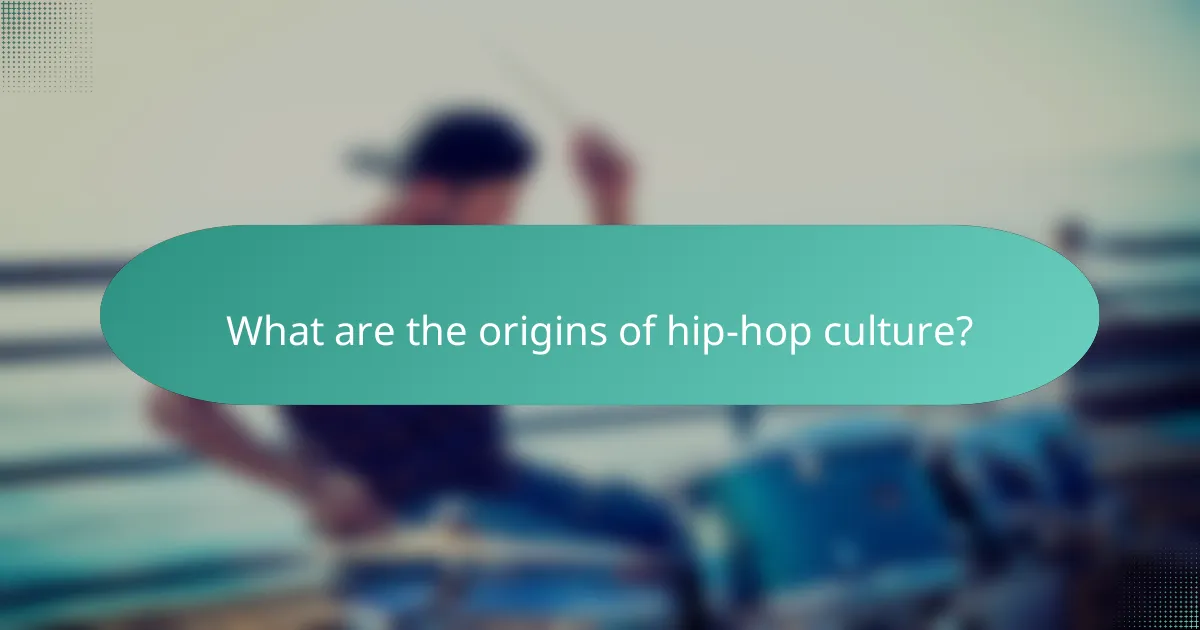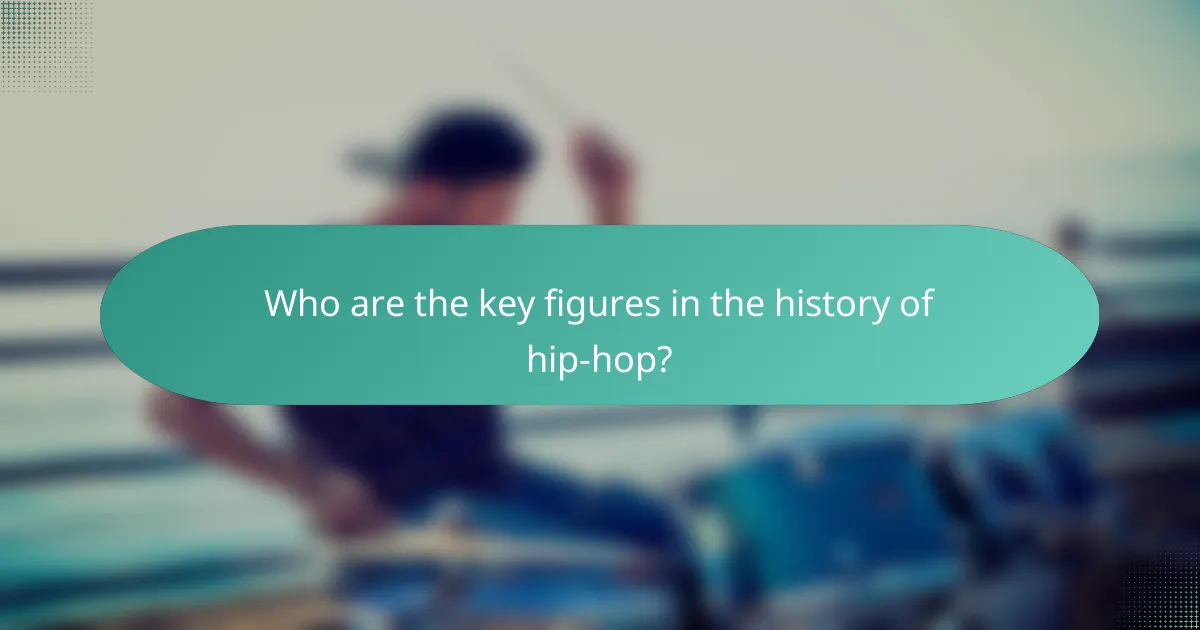Hip-hop is a cultural movement that originated in the 1970s in the Bronx, New York City, primarily as a response to the social and economic challenges faced by African American and Latino communities. It encompasses four main elements: rapping, DJing, graffiti art, and breakdancing. Key figures in hip-hop history include DJ Kool Herc, who pioneered breakbeat DJing, Afrika Bambaataa, who promoted hip-hop as a positive force, and Grandmaster Flash, known for his innovative turntable techniques. The genre’s evolution has been influenced by various cultural movements, including the Civil Rights Movement, the Black Arts Movement, and the Feminist Movement, contributing to its global significance and diverse expression.

What are the origins of hip-hop culture?
Hip-hop culture originated in the 1970s in the Bronx, New York City. It emerged as a response to social and economic challenges faced by African American and Latino communities. The culture encompasses four main elements: rapping, DJing, graffiti art, and breakdancing. The first hip-hop party is credited to DJ Kool Herc in 1973, who introduced breakbeat DJing. This new musical style quickly gained popularity among local youth. Influential figures like Afrika Bambaataa and Grandmaster Flash helped shape hip-hop’s identity. By the late 1970s, hip-hop began to spread beyond New York, influencing music and culture worldwide. The genre’s roots are deeply connected to African American oral traditions and street culture.
How did hip-hop emerge as a distinct genre?
Hip-hop emerged as a distinct genre in the 1970s in the Bronx, New York City. It developed from a blend of various musical styles, including funk, soul, and disco. DJs began isolating beats from songs and creating loops. This practice laid the foundation for breakdancing and MCing. Key figures like DJ Kool Herc pioneered these techniques at block parties. The genre further evolved with the introduction of rapping as a vocal style. By the late 1970s, hip-hop gained mainstream recognition through tracks like “Rapper’s Delight” by the Sugarhill Gang. This marked its transition from an underground movement to a commercial genre.
What social and economic factors contributed to the rise of hip-hop?
The rise of hip-hop was significantly influenced by social and economic factors. Urbanization in the 1970s led to the migration of people to cities, particularly in the Bronx. This created a concentration of communities facing poverty and unemployment. Economic decline in these areas resulted in limited access to resources and opportunities. Social issues, including racial discrimination and police brutality, fueled a desire for expression and resistance. The emergence of block parties provided a platform for DJs and MCs to showcase their talent. Additionally, the availability of affordable turntables and mixers made music production accessible. These factors collectively shaped the cultural landscape that birthed hip-hop.
Which communities were instrumental in the development of hip-hop?
The African American community was instrumental in the development of hip-hop. This community contributed significantly through cultural expressions like music, dance, and art. The Bronx, a neighborhood in New York City, played a crucial role as a birthplace of hip-hop. In the 1970s, DJs began mixing funk, soul, and disco tracks at block parties. These gatherings fostered a sense of community and creativity. Furthermore, Puerto Rican and Caribbean communities also influenced hip-hop culture. They introduced elements like breakdancing and graffiti art. The collaboration among these diverse groups shaped the genre’s evolution. Hip-hop emerged as a voice for marginalized communities, addressing social and political issues.
What key elements define hip-hop culture?
Hip-hop culture is defined by four key elements: rapping, DJing, graffiti art, and breakdancing. Rapping involves rhythmic vocal delivery over beats. DJing includes mixing and manipulating sounds to create music. Graffiti art serves as a visual expression of hip-hop identity and messages. Breakdancing is a dynamic dance style that showcases athleticism and creativity. These elements emerged in the 1970s in the Bronx, New York City, as part of a cultural movement. Each element plays a vital role in the overall identity of hip-hop culture.
How do music, dance, and visual art intersect in hip-hop?
Music, dance, and visual art intersect in hip-hop through a shared cultural expression. Hip-hop music provides the auditory foundation, featuring beats and rhythms that inspire dance styles like breakdancing. Breakdancing, in turn, incorporates movements that are often influenced by the visual aesthetics of graffiti art. Graffiti serves as a visual representation of hip-hop culture, often depicting themes and messages found in hip-hop lyrics. This interconnectedness creates a holistic art form where each element enhances the others. Historical roots trace back to the 1970s in the Bronx, where these art forms emerged simultaneously in urban spaces. Events like block parties showcased DJs, dancers, and graffiti artists, solidifying their relationship. This synergy continues to evolve, influencing contemporary art and music globally.
What role does fashion play in hip-hop identity?
Fashion plays a crucial role in hip-hop identity by serving as a form of self-expression. It reflects the cultural background and personal experiences of artists and fans. Hip-hop fashion often includes streetwear, oversized clothing, and bold accessories. This style originated in the 1970s and has evolved significantly since then. Influential figures like Run-D.M.C. popularized brands like Adidas, showcasing the connection between music and fashion. Fashion in hip-hop also communicates social messages and challenges societal norms. The visuals in music videos and performances further amplify this connection. Overall, fashion is integral to the hip-hop narrative, shaping its identity and cultural significance.

Who are the key figures in the history of hip-hop?
The key figures in the history of hip-hop include DJ Kool Herc, Afrika Bambaataa, and Grandmaster Flash. DJ Kool Herc is credited with pioneering breakbeat DJing in the 1970s. Afrika Bambaataa founded the Universal Hip Hop Culture and promoted hip-hop as a positive force. Grandmaster Flash innovated turntable techniques and is known for his contributions to hip-hop’s development. Other notable figures include Run-D.M.C., who brought hip-hop to mainstream audiences, and Tupac Shakur, known for his impactful lyrics and social commentary. The Notorious B.I.G. also played a significant role in shaping East Coast hip-hop. These artists collectively influenced the genre’s evolution and cultural significance.
Which artists are considered pioneers of hip-hop?
Kool Herc, Afrika Bambaataa, and Grandmaster Flash are considered pioneers of hip-hop. Kool Herc is known for originating the breakbeat technique in the early 1970s. Afrika Bambaataa founded the Universal Hip Hop Culture and promoted peace through hip-hop. Grandmaster Flash developed innovative DJ techniques, including backspinning and punch phrasing. These artists significantly shaped the genre’s early sound and culture. Their contributions laid the foundation for the hip-hop movement that followed.
What contributions did DJ Kool Herc make to hip-hop?
DJ Kool Herc is a foundational figure in hip-hop music. He is credited with originating the breakbeat DJing technique. This technique involves isolating and extending the instrumental breaks of songs. Herc’s innovative approach laid the groundwork for hip-hop’s rhythmic foundation. He also popularized the use of two turntables to create seamless mixes. His block parties in the Bronx in the early 1970s were pivotal in hip-hop’s emergence. These events showcased his skills and attracted large crowds. DJ Kool Herc’s contributions helped shape the culture and community of hip-hop.
How did Grandmaster Flash innovate hip-hop music?
Grandmaster Flash innovated hip-hop music by developing advanced DJ techniques. He introduced the art of “cutting,” which involves switching between two records to create seamless transitions. Flash also popularized “backspinning,” allowing DJs to replay a section of a song instantly. He was a pioneer of “mixing,” blending different tracks to create unique sounds. His innovations enhanced live performances and influenced the overall sound of hip-hop. Flash’s techniques laid the groundwork for future DJs and producers in the genre. His contributions helped define the role of the DJ in hip-hop culture.
What impact have female artists had on hip-hop?
Female artists have significantly impacted hip-hop by introducing diverse perspectives and challenging gender norms. They have expanded the genre’s narrative by addressing issues like empowerment, sexuality, and social justice. Artists like Queen Latifah and Missy Elliott paved the way for future generations. Their contributions have led to increased visibility and representation for women in a male-dominated industry. Statistics show that female artists now account for a growing percentage of chart-topping hits. The success of artists such as Nicki Minaj and Cardi B has further solidified women’s presence in hip-hop. Their influence has inspired a new wave of female talent, reshaping the landscape of the genre. Overall, female artists have redefined hip-hop culture and continue to drive its evolution.
Who are some influential women in hip-hop history?
Some influential women in hip-hop history include Queen Latifah, Missy Elliott, and Nicki Minaj. Queen Latifah emerged in the late 1980s. She broke barriers for women in a male-dominated industry. Her album “All Hail the Queen” showcased her talent and versatility. Missy Elliott revolutionized hip-hop with her innovative music videos and unique sound. Her album “Supa Dupa Fly” became a landmark in the genre. Nicki Minaj gained prominence in the late 2000s. She is known for her distinctive style and lyrical prowess. Each of these women has significantly impacted hip-hop culture and paved the way for future artists.
What challenges have female artists faced in the hip-hop industry?
Female artists in the hip-hop industry face significant challenges. These challenges include gender discrimination and underrepresentation in a male-dominated space. Female artists often encounter stereotypes that undermine their credibility and artistry. They frequently deal with a lack of access to industry resources and networking opportunities. Furthermore, female artists are subjected to objectification and pressure to conform to sexualized images. The pay gap between male and female artists remains a persistent issue. Studies indicate that women in hip-hop receive less radio play and media coverage. These barriers hinder the growth and visibility of female talent in the hip-hop genre.

What cultural movements have shaped hip-hop over the years?
Hip-hop has been shaped by several cultural movements over the years. The Civil Rights Movement in the 1960s influenced hip-hop’s themes of social justice and resistance. The Black Arts Movement also played a significant role by promoting African American culture and identity. The Punk Rock Movement introduced a DIY ethos that resonated with early hip-hop artists. The Latinx and Afro-Caribbean cultures contributed to the genre’s diversity through music and dance influences. The Feminist Movement has inspired female artists to express their perspectives and challenge gender norms within the genre. Additionally, the Globalization of culture has led to the fusion of hip-hop with various international styles. Each of these movements has left a lasting impact on hip-hop, shaping its evolution and cultural significance.
How has hip-hop influenced social movements?
Hip-hop has significantly influenced social movements by providing a powerful platform for marginalized voices. It has served as a vehicle for political expression and social commentary. Artists often address issues like racism, police brutality, and inequality in their lyrics. For example, songs like “Fight the Power” by Public Enemy became anthems for civil rights activism. Hip-hop culture has mobilized communities through events and campaigns, such as the “Hip-Hop for Change” initiative. Additionally, the genre has inspired youth engagement in activism. The Black Lives Matter movement has utilized hip-hop to raise awareness and foster solidarity. Overall, hip-hop’s impact on social movements is evident in its ability to unite people around social justice causes.
What role did hip-hop play in the Civil Rights Movement?
Hip-hop played a significant role in the Civil Rights Movement by providing a voice for marginalized communities. It served as a medium for expressing social and political issues. Artists used their lyrics to address inequality, racism, and injustice. Songs became anthems for protests and rallies. The genre helped raise awareness about civil rights struggles. Notable figures, like Public Enemy and KRS-One, highlighted these themes in their music. Hip-hop also fostered a sense of community and solidarity among activists. Its impact can be seen in the way it mobilized young people for social change.
How has hip-hop contributed to contemporary social justice efforts?
Hip-hop has significantly contributed to contemporary social justice efforts by amplifying marginalized voices. It serves as a platform for artists to address systemic inequalities. Songs often tackle issues like police brutality, racism, and economic disparity. For example, Kendrick Lamar’s “Alright” became an anthem for the Black Lives Matter movement. The genre fosters community engagement through events and discussions. Artists frequently collaborate with activists to raise awareness. Hip-hop’s global reach allows it to influence social movements worldwide. This cultural expression unites people in the fight for justice and equality.
What are the major sub-genres of hip-hop?
The major sub-genres of hip-hop include East Coast, West Coast, Southern, and Midwest hip-hop. East Coast hip-hop is known for its complex lyrics and influences from jazz and soul. West Coast hip-hop often features laid-back beats and themes of life in California. Southern hip-hop incorporates elements of bounce and trap music, emphasizing rhythm and bass. Midwest hip-hop is characterized by its diverse styles and innovative production techniques. Each sub-genre has contributed to the evolution of hip-hop culture since its inception in the 1970s.
How do different regional styles influence hip-hop music?
Different regional styles significantly influence hip-hop music by shaping its sound, themes, and lyrical content. Each region in the United States has developed unique stylistic elements. For example, East Coast hip-hop is known for its complex lyrics and sampling techniques. West Coast hip-hop often features laid-back beats and funk influences. Southern hip-hop incorporates heavy bass and rhythmic flows, reflecting local culture.
Regional influences also affect the subject matter of the lyrics. East Coast artists often address urban struggles and social issues. In contrast, West Coast artists may focus on lifestyle and party themes. Southern hip-hop frequently celebrates local culture and pride.
The diversity of these regional styles enriches the overall hip-hop genre. It allows for a wide range of expressions and connections to local communities. This variety has contributed to hip-hop’s evolution and global appeal.
What are the characteristics of trap music compared to boom bap?
Trap music is characterized by its use of heavy bass, hi-hats, and synthesizers. It typically features a tempo between 130-170 BPM. The lyrical content often revolves around themes of street life and struggles. In contrast, boom bap is known for its use of hard-hitting drums and samples from jazz or soul music. Boom bap usually has a slower tempo, typically around 85-100 BPM. Lyrical themes in boom bap often focus on social issues and personal storytelling. The production style of trap is more electronic, while boom bap relies on traditional sampling techniques. This distinction highlights the evolution of hip-hop from its roots to contemporary styles.
What are some key takeaways for understanding hip-hop culture today?
Hip-hop culture today is characterized by its global influence and diverse expressions. It encompasses music, dance, fashion, and visual art. The genre has evolved from its roots in the Bronx during the 1970s. Key figures like DJ Kool Herc and Grandmaster Flash shaped its foundational elements. Today, hip-hop reflects social issues, identity, and community. Streaming platforms have expanded its reach and accessibility. Collaborations across genres have further diversified its sound. Hip-hop also serves as a voice for marginalized communities, addressing topics like inequality and injustice. Its cultural impact is evident in mainstream media and youth culture worldwide.
How can one engage with hip-hop culture in a meaningful way?
One can engage with hip-hop culture in a meaningful way by participating in local events and workshops. Attending live performances connects individuals with artists and the community. Learning about hip-hop history enriches understanding of its cultural significance. Exploring various forms of hip-hop, such as breakdancing and graffiti art, fosters appreciation for its diversity. Collaborating with local artists can lead to shared creative experiences. Supporting independent hip-hop artists helps sustain the culture. Engaging in discussions about social issues represented in hip-hop promotes awareness and activism. Volunteering for organizations that promote hip-hop education can create lasting impact.
What are the best practices for appreciating hip-hop’s artistic expressions?
To appreciate hip-hop’s artistic expressions, engage actively with the music and culture. Listen to lyrics closely to understand the storytelling and social commentary. Attend live performances to experience the energy and creativity firsthand. Explore the history of hip-hop to grasp its cultural significance and evolution. Analyze different styles, such as rap, DJing, and breakdancing, to appreciate their unique contributions. Support local artists to foster community and diversity within the genre. Read literature and watch documentaries about hip-hop to gain deeper insights. Participate in discussions and forums to share perspectives and learn from others. These practices enhance understanding and appreciation of hip-hop’s rich artistic landscape.
The main entity of the article is hip-hop culture, which originated in the 1970s in the Bronx, New York City, as a response to social and economic challenges faced by African American and Latino communities. The article outlines the four key elements of hip-hop: rapping, DJing, graffiti art, and breakdancing, and discusses the influential figures such as DJ Kool Herc, Afrika Bambaataa, and Grandmaster Flash who shaped its development. It further explores the social and economic factors that contributed to the rise of hip-hop, the intersection of music, dance, and visual art within the culture, and the impact of female artists and cultural movements on its evolution. Additionally, the article examines the genre’s influence on social movements and its major sub-genres, providing a comprehensive overview of hip-hop’s significance and ongoing cultural relevance.